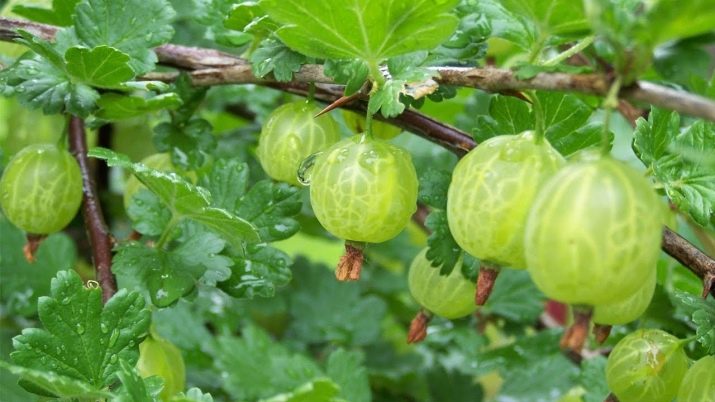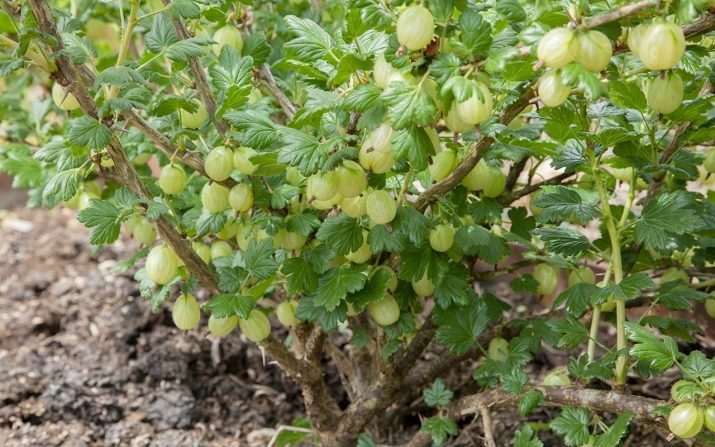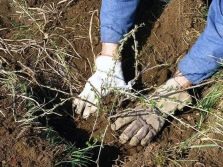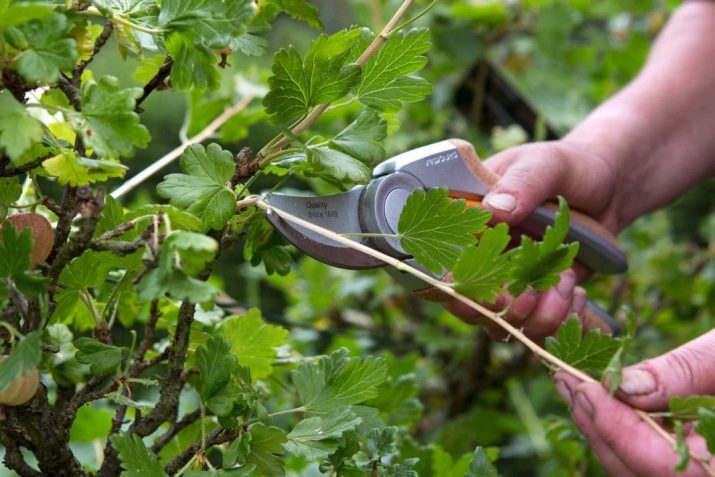Gooseberry "Beryl": description and agricultural technology
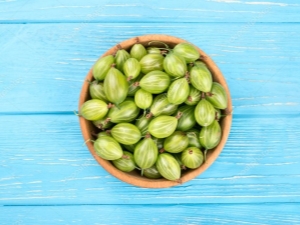
Gooseberry is not only tasty, but also very useful. It has many varieties, each of which is characterized by its pluses and minuses.Many of the inhabitants of the country planted this plant in their garden, but the problem arises during the harvest. This shrub is quite prickly, so injuries and scratches are not uncommon when picking berries. A new variety with a lot of advantages is the gooseberry "Beryl", which has already managed to gain popularity in the backyard of the country.
Characteristic variety
Bush at the gooseberry "Beryl" is characterized by medium size, it reaches a height of about one meter. Crohn dense with large leaves of green. Each of the leaves is five-blade, it has large and sharp teeth at the edges. The plant has no pubescence. The shape of the shoots is curved and the top down. Each of the petioles has an average size and a small edge. The gooseberry flower is large, with a toothed shape and a two-colored inflorescence.
"Beryl" refers to winter-hardy cultures, it does not need to be covered, even if the temperature drops to minus thirty-eight degrees. The variety has an average ripening period, so in mid-July you can harvest. Fruits are not characterized by large size, each of them weighs at least four grams. During the season, about ten kilograms of berries can be harvested from one bush.
Gooseberry berries have a smooth surface without pubescence. The color of the fruit is light green, with a thin skin that can be easily eaten. “Beryl” is a dessert variety, because its fruits are sweet-sour, they have good juiciness and refreshing effect. Gooseberry lies for a long time after harvest and tolerates transportation.
Advantages and disadvantages
Variety "Beryl" has some advantages compared with other types of gooseberry. Of the main advantages are the following:
- high resistance to freezing temperatures;
- rare infection with powdery mildew, fungal infections;
- excellent quality of taste;
- self-growing, this gooseberry gives a rich harvest without the presence of a pollinator;
- a small number of thorns that are at a safe distance for a person;
- the fruits are not small, they are well stored and transported.
The gooseberry provides summer residents not only with tasty berries, but also charges with the mass of vitamins and useful elements at its use in food. The variety has a universal purpose, it can be eaten raw and canned. The therapeutic effect of the fruit:
- elimination of disorders in the stomach and intestines;
- high potassium content allows you to remove edema;
- tonic effect;
- normalization of metabolism and blood pressure.
Among the shortcomings can be identified poor resistance to septoria, so he needs constant preventive measures.
How to plant?
Works on planting this gooseberry are carried out in spring or autumn before frosts come. A landing site should be open and well lit, a hill with a lack of strong wind is best suited. It is not recommended to plant "Beryl" in a swampy area where groundwater is located close to the surface. Stages of soil preparation:
- if the soil has high acidity, it should be lowered using lime or dolomite flour, three hundred grams of the substance will be enough for one well;
- it is required to dig the territory, leveling and destroying the weed on it;
- digging a hole that has a depth of 0.4 meters;
- heavy soil should be lightened by fertilizing;
- prior to planting it is worth adding phosphate or ash.
After the well is fully prepared, it is necessary to pour compost, mineral fertilizer and fertile soil to its bottom. Having carried out mixing, it is worth doing leveling the root system. Then in the hole you need to fill the fertile soil, compacting the ground around the seedling. Do not forget that the landing of the bush should occur in a horizontal position.
The best option for planting will be a sapling, which is more than two years old, with a healthy and formed root system. A stiff and strong trunk is a guarantee that the plant will take root.
Care
Despite the fact that "Beryl" quite unpretentious, he needs care. No owner should forget about the regular loosening of the soil around the plant. Such work should be done very carefully, so as not to damage the root system of the bush. During the summer season, loosening should be carried out no less than five times. Processed soil promotes oxygen to the roots, which improves the growth and yield of gooseberries.
In the autumn time, "Beryl" requires cutting off dry and excess branches in order to avoid thickening of the bush.
Pruning infected branches is a guarantee to prevent the spread of infection, as well as a sufficient amount of nutrients for the shoots.
This variety produces abundant yields, but this happens when the soil is well fed. That is why during the season the shrub should be fertilized. In the springtime, gooseberries need supplements with nitrogen, which promotes good plant growth. In addition, fertilizing organically favorably affects the development of "Beryl". When the flowering of the shrub is over, fertilizer with potassium and phosphorus can be added to the soil. The last dressing is carried out before the start of frost.
Diseases and pests
This variety of gooseberry is quite resistant to diseases and parasites. However, the plant often attacks septoria. This is a fungal disease that manifests itself as gray and rust stains on the leaves. If the infection is severe, then the gooseberry dries and dies. The development of this infection is promoted by thick plantings of plants, as well as wet weather. To combat septoria is required to perform the following activities:
- clean and burn the affected fallen leaves;
- dig up the ground;
- thin out thickening;
- fertilizer that increases resistance to the disease;
- spray the preparation against the fungus.
Of insect pests on the shrub often attacks aphid, moth and sawfly. To neutralize them, it is necessary to treat the plant with a solution with the addition of ash and soap or Bordeaux mixture.
Reviews
Reviews of gooseberries are often found, with the variety "Beryl" they are the best. Many gardeners and gardeners recommend this plant for planting. The reasons for such demand berry bush are its high yields, unpretentious care. Consumers respond to berries as well, mostly praise their pleasant taste and sweetness. Residents of the Urals say that despite the harsh and rainy climate, the plant is well established and gives excellent yields.
For more information about beryl gooseberry, see the next video.

